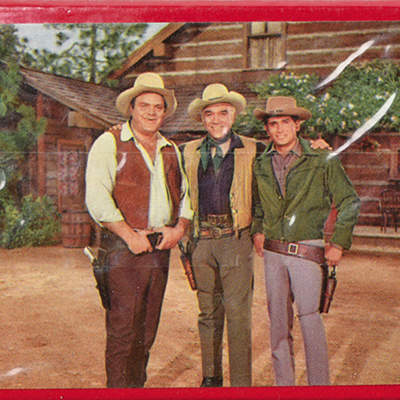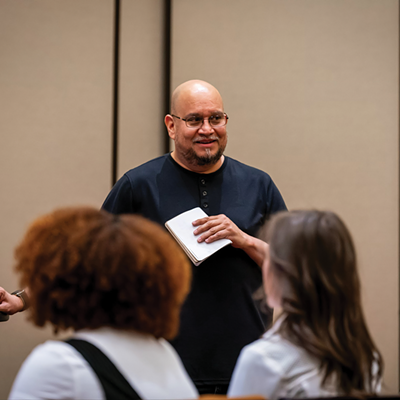Huckelberry was in the most select group of this select group. He also had been at Diamond's 70th, and Diamond had made it clear that those who didn't make the cut for this year's party--bankers and lawyers--were no longer needed by him. Apparently Huckelberry is needed, even though he and his host are gunning for one another in an ugly, costly battle over Old Tucson, the once-famous Western movie set ravaged by fire in 1995.
At the party, guests were treated as if they were on a cruise, where admission was gained through "boarding pass" invitations. Guests ate as they could nowhere else in Tucson while being entertained by a band flown in from New York. The party was so lavish that its cost easily could have covered the $124,410 that Old Tucson--run by a company controlled by Diamond and Donald Pitt, buddies from their days at the University of Arizona--owes in back rent and late charges.
After sending a default notice to Diamond and Pitt last summer, Huckelberry--with clearance from a Pima County Board of Supervisors that has historically catered to Diamond--saddled up two county lawyers to sue Old Tucson on March 13. The company's answer to the complaint, assigned to Judge Carmine Cornelio of Pima County Superior Court, is due today (May 1), one day after Old Tucson's first-quarter 2003 rent was due.
Diamond and Pitt--whose father operated a jewelry store downtown at Stone Avenue and Congress Street--have begged the showdown with repeated delays in payment, squabbles over details of rent credits, and the hope that their lease, renewed with favorable terms in 1996, can be rewritten to chop their minimum rent payment to the county from $300,000 a year to $50,000.
The two also have a hold card: They have lined up Lowell Rothschild, a top-flight bankruptcy lawyer whose firm has also done work for the county.
Pitt, a lawyer and former member of the Arizona Board of Regents, joined with Diamond and another longtime friend, investor Richard Bloch, to buy the lease to Old Tucson in 1985 from a company headed by Robert Shelton. They paid $3.5 million to acquire the 100 buildings of the movie set and theme park that Shelton restored and built up when he, a country club consultant from Kansas City, took over the park in 1959. (Bloch, also a partner in the Diamond-Pitt landmark deal to acquire and sell off land in the Howard Hughes Trust--a package that made the three wildly rich--is no longer part of Old Tucson.
The Old Tucson debt is tiny for someone with Diamond's wealth. It is a wealth exemplified by his ability to write an eight-figure check to get out of the tricky Banning-Lewis Ranch deal in Colorado before the collapse of one of the many crashing thrifts in the dawn of the Resolution Trust Corp. (It must be said that Pitt and Diamond also give, to medical research and other charities, more than many make in a lifetime.)
But this costly battle goes on--at a time of county budget cuts and at a time that Old Tucson itself is flailing.
OLD TUCSON'S HEYDAY was as a movie studio. Yet, Diamond, Pitt and others cling to the hope that it can have a successful future as a water park.
Yes, a water park.
Laugh as you might at the recommendations for an Old Tucson water park. It is what the consultants recommend, and they play a big role with Diamond and Pitt. Critics point out that consultants are the ones who guided them away from Old Tucson as a big movie set and to today's amusement park with sharply dwindling attendance.
Rather than rebuild the soundstage, the famous and important Kansas Street shooting area, the old mission and other critical features used in movies for decades, Diamond and Pitt chose consultants' designs, trading the movie-making history--Old Tucson was created by Columbia Pictures for the 1939 movie Arizona--for a $14.95-per-adult tourist trap.
The Western theme, one consultant assured, will be retained "with lifeguards wearing cowboy hats, etc. A Western-themed water park would be a lot of fun."
"(The) target market would change radically," said Will Koch, president of the Holiday World, a theme park in the southern Indiana village of Santa Claus. "The rides and water park would be the primary draw, with the western theme simply providing the 'flavor' of the park."
Koch's ideas were part of a fantasy presented to Old Tucson owners on Nov. 25 by Pete Mangelsdorf, chief executive officer at Old Tucson, and Tom Moulton, the county's manager for the leased property. Moulton could speak like an insider because, until October 2000, he worked for Old Tucson Studios.
The November brainstorming came four months after Huckelberry finally decided to call out Diamond, when he had county Parks Director Rafael Payan serve Old Tucson with notice of default. Though friendly with Diamond, Huckelberry has watched the savvy speculator circle around him and county government for decades on huge land deals like the Rocking K Ranch, Pima Canyon and several big land swaps. The rivalry simmers most on Huckelberry's legacy: the Sonoran Desert Conservation Plan. Despite reports that he is trying to be more tolerant of the land preservation plan, Diamond, the son of a New York coffee broker, once belittled it as "dipshit."
Still, this rivalry returns to Old Tucson's dusty streets because of escalating, unpaid bill and the court action.
BACK IN THE DAY, Robert Shelton was Tucson's movie man, a charismatic, energetic sort who befriended John Wayne (who became a partner in Old Tucson), Elizabeth Taylor and scores of other movie and television actors, producers and directors. He single-handedly lured movie after movie to Tucson.
He loves--without boasting--to tell the story about how he once had five production companies working at Old Tucson at one time. He had Wayne, Burt Lancaster, Clint Eastwood and Lee Marvin simultaneously working on films. Shelton could configure five or six sets at Old Tucson, he says.
Shelton had a knack with movie folks. Eastwood built Old Tucson's courthouse. Paul Newman built the boarding house for Hombre. Shelton got the Reno, the oldest operating locomotive, from MGM.
Shelton is friendly with Diamond, and says that when they were discussing the sale of the lease from Shelton's control to Diamond/Pitt control, in 1985, he considered Diamond a close friend.
"We had been in business together with Alumni Publishing Co.," he recalls. "I was kind of a boob. He is the most focused human being I know. He's got to come out with it all."
Old Tucson became a company for the investors' kids--a toy, critics contend. But they apparently were not impressed enough with the movie business to keep it going like Shelton did.
Diamond's daughter, Helaine Levy, was installed as the CEO and president. A succession of general managers came through the turnstiles. One, Dan Aylward, infuriated directors and producers by walking onto live sets.
Aylward had a much better time with the Board of Supervisors, making repeated requests for more lenient lease terms and for admission increases.
Under a 1973 lease with Shelton, the county collected $38,000 a year in minimum rent and allowed 25 percent of the rent to be applied to maintenance. In 1988, minimum rent was raised to $200,000, but generous rent credits were expanded and often not policed.
Indeed, Diamond and Pitt became so cozy with the county agency that administers the lease, Parks and Recreation, that then-Director Gene Laos and two of his friends operated in 1988 the Three Amigos restaurant--in space Old Tucson leased from the county. The conflict of interest netted Laos only a brief suspension.
In early 1995, records show, the problems of late rent payments and maintenance issues prompted county lawyers to persuade the Board of Supervisors to tell Old Tucson officials to shape up or face default. And on April 18, 1995, the Board of Supervisors hired former deputy county attorney Michael Callahan to help untangle the knots of the Old Tucson lease and to provide consultation for lease renewal.
Disaster intervened six days later. At about 6:30 p.m., fire raced through Old Tucson and devoured its mostly wood buildings, destroying half the movie set and theme park.
TERRY POLLOCK IS AN OLD friend of the Diamond and Pitt families. He became a familiar face and voice with the public through his advertising agency and his work to keep Central Arizona Project water from being pumped into Tucson homes.
He now is a voice for Old Tucson, as a $90,000-a-year vice president for strategic development. In radio appearances he frequently describes the fire catastrophe as a "perfect storm."
High winds. A Drexel Heights fire crew out in Three Points for a training exercise. The lack of water on site because firefighters could not get to the source. That, he says, resulted in the major damage.
Records show more. Old Tucson officials chose to dissemble a pump that in fact needed maintenance work rather than allow for it to operate, even at lower capacity.
Old Tucson and Pima County officials also failed to get necessary fire inspection from the state fire marshal and failed to submit construction and renovation plans for review by the fire marshal. County officials didn't require fire prevention devices like sprinklers and allowed the park to have less than a quarter--67,000 gallons--of the needed 300,000 gallons on hand. Water lines also were too small.
Pima County's lax attitude culminated in 1987, when it stopped inspecting Old Tucson buildings altogether. Of the 100 buildings at the time of the fire, just three had sprinklers.
On that fateful April 1995 evening, fire swept so fast that crews had little chance of preventing the loss. Among the treasures cited by Shelton and other experts as lost were the soundstage, built in 1966, and the vast--and in some cases, historically significant--wardrobe.
Huckelberry, whose party for his temporary retirement from county administration was held at Old Tucson in the spring of 1993, was stunned the night of the fire and somewhat apologetic if realistic about its tinder-box condition. Old Tucson, he said, "grew up like an Old West town. Hodge podge."
Shelton was home that evening when a television reporter called for an interview. He "could see the glow" from the foothills.
"There was nothing I could do but cry. The next day we went out to take a look. I was numb. It looked like burned-out Berlin."
While arson was quickly suspected, there have been no arrests. The cause remains unknown.
SHELTON AND OTHERS IN the movie and commercial film business now lament the new Old Tucson. Following the course set out by consultants, Diamond and Pitt left out Kansas Street, the soundstage and other components that are critical for movie and television productions.
"They oversized the courthouse, oversized the saloon, there are no shooting streets and they undersized everything else," Shelton said.
When Old Tucson reopened a visitors' center and gift shop, it sold ashes from the fire.
Even today, it's unclear exactly how much damage the fire did, in terms of finances. Insurance coverage, according to county records, was put at $5 million. The loss was first listed at $10 million, then $5 million. When Old Tucson reopened in 1997, then-General Manager Bob Kenniston boasted of a $13 million renovation. And in a recent editorial backing Old Tucson and condemning Huckelberry's actions, the Arizona Daily Star boosted the renovation to $18.5 million.
Yet when Old Tucson's longtime legal counsel, T. Patrick Griffin, approached the Board of Supervisors in 1996 to restyle the lease and to give its blessing to a Bank One loan, the figure cited was much less. Bank One was providing a $5.5 million construction loan, minutes from that Oct. 22, 1996 meeting show. Huckelberry, without correction from Griffin, said the "reconstruction budget, including design fees, is around $9.5 million. The insurance proceeds are $4 million and this is the balance."
Ever since the fire, Old Tucson's management and the county have been at odds over money. In 1996, supervisors approved a rent credit concession totaling $2.75 million. That infuriated Democrat Dan Eckstrom, who said at a July 16, 1996 meeting that the rent credit "is another form of corporate welfare."
At a subsequent meeting, Eckstrom said: "The point is very simple: The $2.75 million is equivalent to a loan." County audits earlier showed that Old Tucson "commingled" money that was supposed to go to building maintenance with other accounts.
Eckstrom, whose District 2 includes his native South Tucson and much of the southside, also bristled at the suggestion that Old Tucson's offer to provide 1,000 admissions for underprivileged kids was generous.
"Considering Old Tucson is open for approximately 360 days, on a most generous day Old Tucson would allow a little under three kids per day entrance to Old Tucson," Eckstrom said. "Is this something that shows social responsibility?"
But Eckstrom could pick up only a second, from then-Supervisor Raúl Grijalva, a Democrat. Republicans Ed Moore, Paul Marsh and Mike Boyd pushed through the changes Diamond and Pitt sought.
Eckstrom declined last week to say: "I told you so."
EVEN WITH HUCKELBERRY LOADING up and preparing to lock out Diamond's group, supervisors are skittish about ordering the two Dons to ride out. Their political influence is beguiling and overpowering.
Diamond's boys, Mangelsdorf (the CEO), Pollock (the vice president), and Griffin (the counsel) have been busy seeking a reprieve from the county bill. Business, they say, has taken a hit from the drop in tourism after the Sept. 11, 2001 terrorist attacks and the gloomy economy.
Five weeks before Old Tucson fell into default, Mangelsdorf--who did his MBA thesis on Old Tucson--said in a memo to Diamond that part of Old Tucson's problem was that it was paying too much in base rent to the county. Further he wrote, while the accrued rent credit is $475,000, "Old Tucson Co. does not have the cash or the projects to spend $475,000."
Mangelsdorf has taken time to complain about the short notice given for the inspections that the county now performs. The county hired Gale Bundrick, a respected former high level county parks administrator, to do them. Bundrick listed more than 100 areas requiring repair and improvement, according to county records. They ranged from permanent protection for the John Wayne Museum to multiple roof repairs.
And Old Tucson has proposed novel--and rejected--invoices for reimbursement under the rent credit provision. Mangelsdorf wanted taxpayers to provide a subsidy of more than $13,000 for the administrative costs of listing rent-credit projects, county records show. The item was rejected, as was $4,150 for Old Tucson's acquisition of a 35-foot saguaro that experts say will not survive.
Rent to the county has dropped, since reopening, from $493,000 in 1997 to $335,000 last year. Gross sales have dropped from a pre-fire high of $8.46 million in 1994 to $6.1 million. Attendance--once enough to be second or third among Arizona attractions after the Grand Canyon and the Arizona-Sonora Desert Museum--is down to 300,000 a year compared to the half-million it once drew.
None of that has caused Huckelberry to ease off the trigger.
"The Pima Air and Space Museum has had the highest attendance and revenue summer since their inception, and attendance and revenue at the Desert Museum was up this summer as well," Huckelberry told Griffin in a Sept. 25 letter.
Griffin pleaded for more county help. In a question that he split into 11 lines for emphasis, Griffin wrote: "Is there anything else Old Tucson can do that is: new, sensitive to the environment, Western themed, family oriented, makes you want to come back, reasonably priced, works in hot weather during the day, works in cold weather at nighttime, appeals to the locals, approved by the county?"
While Pollock makes appearances in which he alternately says Old Tucson is withholding rent because of slow business and to force the county to renegotiate or rebid the lease, Griffin in that Sept. 16 letter to the county lawyers said the Diamond-Pitt group "spent in the neighborhood of $10 million rebuilding Old Tucson and that was based on financial projection developed by theme park experts, scrutinized by the bank and reviewed by the county ..."
The letter goes on. "Just since the second half of 1998, the Old Tucson owners have advanced $1,720,817 of their own money to Old Tucson, and borrowed another $1.55 million to put in Old Tucson that they had to personally guarantee. That is in addition to the $3.5 million in existing bank debt. The bank has also been paid several million dollars."
But Pitt has acquired the Old Tucson loans originally made by Bank One. Now he is seeking ways to boost revenue.
According to a Sept. 30 memo that Pitt sent to Diamond, the attractions "still do not provide a draw during the May through September season, which in my opinion can only be satisfied with water elements and a water park utilization."
Tom Burke and Wendy Peterson, the deputy county attorneys handling the matter, said in response that they had "repeatedly and unequivocally stated to Pat Griffin and Donald Pitt that the county will not accept water rides, elements or features."
The matter is further complicated by statements from Huckelberry's inside man, Tom Moulton, the former Old Tucson executive now on the county payroll for $96,862 a year.
Moulton had advanced proposals for a "flume" and "log rolling" at Old Tucson.
He also drew a scolding from the county lawyers for perpetuating the theory that the county and Old Tucson could be business partners and that county officials could sit on the Old Tucson board.
In one settlement discussion, the county would put base rent at $50,000 a year, to be paid monthly, plus 10 percent of anything over $5 million in gross sales, with five-year adjustments according to the Consumer Price Index. Old Tucson would be confined to 120 acres, leaving the county with the 240-acre balance. Most important, the controversial rent credit for buildings would be scrapped--and the sound stage rebuilt using past rent and past rent credits.
If it fails, Huckelberry will have no choice but to draw down on Diamond and his boys.










